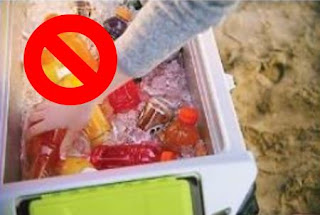On average, American consumers buy four bags of packaged
ice each year, usually in the summer months.
Locally we see packaged ice in cubes and blocks. But
no matter what the shape or the source, ice is considered a food by the FDA or Food and Drug Administration. If it is
made in one state and sold in another, packaged ice is regulated, as a food.
FDA rules require that packaged ice must be produced with properly cleaned and
maintained equipment from water that is safe and sanitary, and that it is
stored and transported in clean and sanitary conditions. That’s just the first step.
To avoid a summer bummer, make sure you handle packaged ice
safely and treat it like it's a food. That is the second step. Here are some tips:
 At Home - Use clean, non-breakable utensils to handle ice,
such as tongs or an ice scoop. Avoid
touching ice with unwashed hands or using a clear glass to scoop the ice. There
is a chance for the glass to break and leave pieces of broken glass in the ice
that can hurt someone. Scooping ice with
dirty hands also transfers germs to the ice and that that can make people sick.
At Home - Use clean, non-breakable utensils to handle ice,
such as tongs or an ice scoop. Avoid
touching ice with unwashed hands or using a clear glass to scoop the ice. There
is a chance for the glass to break and leave pieces of broken glass in the ice
that can hurt someone. Scooping ice with
dirty hands also transfers germs to the ice and that that can make people sick.
Store ice only in clean and sanitized containers that are
safe for storing food. If you have an
ice maker in your refrigerator, wash it out a couple times during the year,
more often if people reach into the ice maker with unwashed hands.
For Picnics or Parties make sure your cooler is cleaned
with soapy water and rinsed with a sanitizing solution made with one tablespoon
of bleach to one gallon of lukewarm water. Let the container air-dry or pat it dry
with fresh paper towels. Do this after
every use or before using if the cooler has been in storage.
When raw foods are packed with loose ice in a cooler the
food should be wrapped securely to prevent water from the melting ice from
cross-contaminating the foods in the cooler.
For example, juices from raw meat could be carried to vegetables or
fruit that will be eaten raw. Pack food like
raw meat that has the highest risk of contaminating other foods at the bottom
of the cooler. Pack the ready to eat
foods like raw veggies, fruit, pre-cooked meats, salads and canned drinks near the top
of the cooler.
Two other important tips to remember: 1) if you are planning to use ice in drinks, put
that ice in a separate bag in a separate cooler and then use ice scoops or
tongs so that dirty, unwashed hands are not introducing bacteria that can make
people sick into the ice. This is
especially important if you have young children, the elderly or people who are
immune compromised attending the picnic or party.
Never use ice from a cooler that is used to cool raw foods, canned or bottled drinks where people touch ice with unwashed
hands. 2) Avoid dropping the bagged
ice on a dirty floor, cement or the ground because it creates holes in the bag which can introduce harmful bacteria. Dirt can get on the outside of the bag and when the
bag is emptied into a cooler, the dirt can fall off the bag and contaminate the
ice and whatever else the ice touches. Or dirt and germs can get to the ice through the little holes that are made when the plastic breaks open when it is dropped. The ice can also be
contaminated this way and people do not realize that.
People who are at risk the most for food borne illnesses include:
*Young children - 9 years and younger
*the Elderly - 65 years and older
*People who are Immunocompromised: chronic illness, diabetic, pregnant or nursing, going through cancer treatment, recovering from surgery... Since it is hard to really know for sure, the best bet is to simply treat everyone as if they are at risk for food borne illnesses and take all the precautions you can.
x

No comments:
Post a Comment